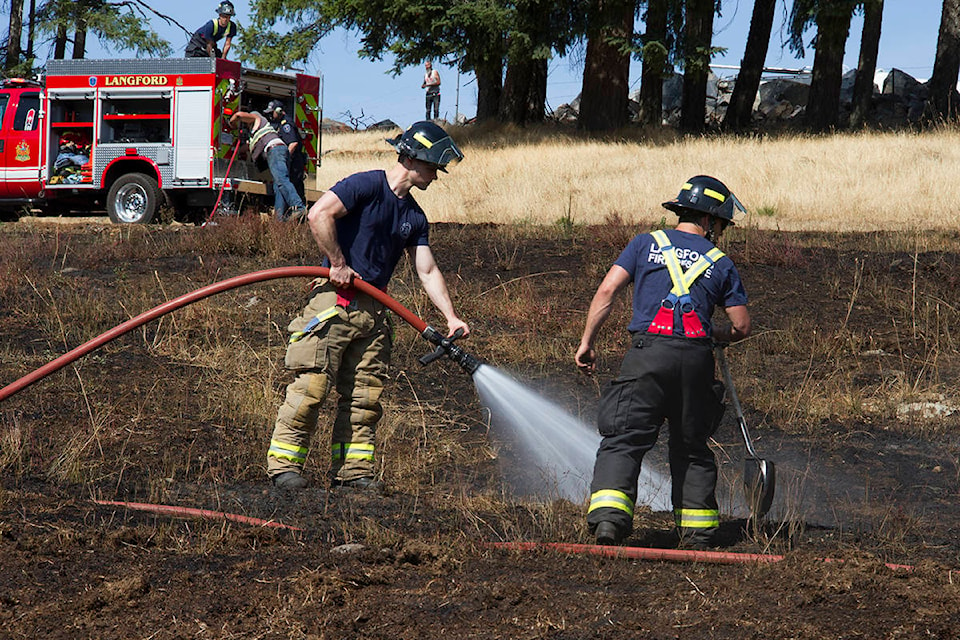Vancouver Islanders might be loving the recent glorious spring sunshine, but it could come with a cost.
Greater Victoria has seen one of the driest seasons on record so far, raising concerns for an upcoming summer season. The worries are amplified by the fact that presently firefighters and first responders are preoccupied with COVID-19.
According to Environment Canada, March was set to be the driest on record until 13.6 mm of rain fell in Victoria on March 30.
RELATED: March precipitation way below normal
“Without that, it would have had us at under 10 per cent of the normal average, which is 78.4 mm,” explained meteorologist Armel Castellan. “Either way it was super dry at 36 per cent the normal amount, making it the sixth driest on record since 1941.”
April is continuing with the sunny streak, so far accumulating 4.8 mm of rain as of April 14, when on average the month sees a total of around 50 mm.
“It is safe to say that April is also going to be extraordinarily dry,” Castellan said. “On the Island, it quickly becomes a drought and wildfire concern when we have the antecedent conditions.”
It’s a situation that is not unique to the south Island. In Campbell River, precipitation in April so far has been eight per cent of normal, BC Hydro reports. That’s following a March that saw precipitation levels 55 per cent of normal. February was 94 per cent of normal.
In the Comox Valley, this is the fourth consecutive year where the February to March period has had well below normal precipitation. The amount of precipitation for February was 48 per cent of normal, 31 per cent in March and 14 per cent in April to date.
Chemainus reported March rainfall at less a third of what it normally would expect. Cowichan has started operation of its weir early to store more water in Cowichan Lake to avoid the possibility of the river running dry.
RELATED: Weir in Cowichan Lake begins operations early this year
Planning ahead for a potential wildfire season, however, has been put on the back-burner as frontline workers continue to respond to the COVID-19 pandemic.
“We haven’t had too much time to think about it,” said Victoria Fire Chief Paul Bruce. “Right now we’re sitting here with our fingers crossed hoping that management strategies are in place where they are needed most.”
“It’s a lot of extra work in relation to attempting to support the province in their planning for social distancing, management of the vulnerable population, and certainly coming to terms with any issues with exposure,” Bruce said.
He added, however, that usually Victoria doesn’t see too many large wildfires, and that only a handful of members of the department are usually sent to interior B.C. to assist with wildfire fighting. These members have specific forestry training which allows them to hold management roles if required.
“What that provides us is the ability to assist by sending up one member and not depleting our crews,” he said.
At this point, this should still be a possibility if it is required.
RELATED: Province extends COVID-19 fire ban until June 15
Esquimalt Fire Chief Chris Jancowski is one of the people in his department who has the specialized forestry training, and worked during the wildfires of 2017 and 2018.
Jancowski said that despite a recent change in fire fighting protocols, such as limiting unnecessary residential visits and pausing any educational components, firefighters would still be able to help with forest fires if needed.
One catch-22, he added, is that due to social isolation there may be fewer people on local trails.
“Some larger parks with areas inland could see brush fires, and without people on trails reporting might be delayed,” he said. “But the cross over is that some people that use those trails have habits like smoking. With decreased people, that could mean decreased chances of fires, too.”
For more news from the Island and beyond delivered directly to your email inbox, click here.
— with files from Black Press
Like us on Facebook, send a Tweet to @NicoleCrescenzi
and follow us on Instagram
